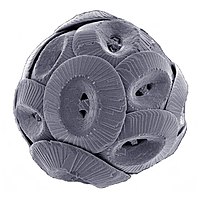
Photo from wikipedia
Coral polyps have a fluid-filled internal compartment, the gastrovascular cavity (GVC). Respiration and photosynthesis cause large daily excursions in GVC oxygen concentration (O2) and pH, but few studies have examined… Click to show full abstract
Coral polyps have a fluid-filled internal compartment, the gastrovascular cavity (GVC). Respiration and photosynthesis cause large daily excursions in GVC oxygen concentration (O2) and pH, but few studies have examined how this correlates with calcification rates. We hypothesized that GVC chemistry can mediate and ameliorate the effects of decreasing seawater pH (pHSW) on coral calcification. Microelectrodes were used to monitor O2 and pH within the GVC of Montastraea cavernosa and Duncanopsammia axifuga (pH only) in both the light and the dark, and three pHSW levels (8.2, 7.9, and 7.6). At pHSW 8.2, GVC O2 ranged from ca. 0 to over 400% saturation in the dark and light, respectively, with transitions from low to high (and vice versa) within minutes of turning the light on or off. For all three pHSW treatments and both species, pHGVC was always significantly above and below pHSW in the light and dark, respectively. For M. cavernosa in the light, pHGVC reached levels of pH 8.4–8.7 with no difference among pHSW treatments tested; in the dark, pHGVC dropped below pHSW and even below pH 7.0 in some trials at pHSW 7.6. For D. axifuga in both the light and the dark, pHGVC decreased linearly as pHSW decreased. Calcification rates were measured in the light concurrent with measurements of GVC O2 and pHGVC. For both species, calcification rates were similar at pHSW 8.2 and 7.9 but were significantly lower at pHSW 7.6. Thus, for both species, calcification was protected from seawater acidification by intrinsic coral physiology at pHSW 7.9 but not 7.6. Calcification was not correlated with pHGVC for M. cavernosa but was for D. axifuga. These results highlight the diverse responses of corals to changes in pHSW, their varying abilities to control pHGVC, and consequently their susceptibility to ocean acidification.
Journal Title: Coral Reefs
Year Published: 2020
Link to full text (if available)
Share on Social Media: Sign Up to like & get
recommendations!